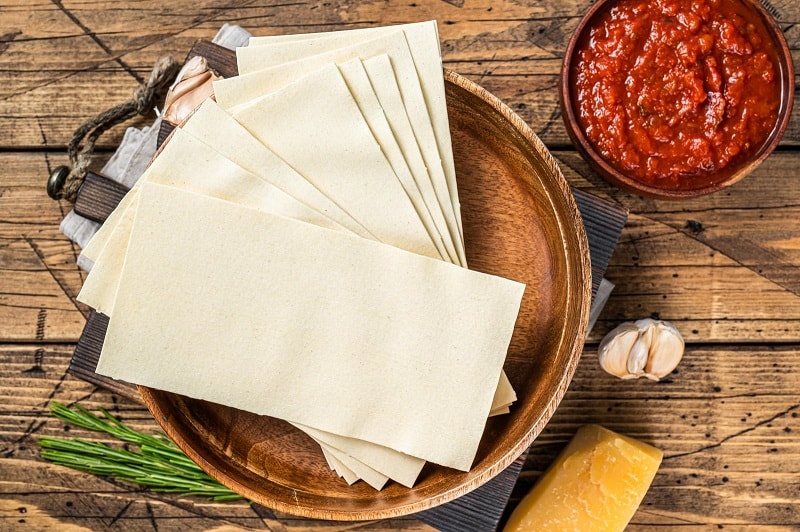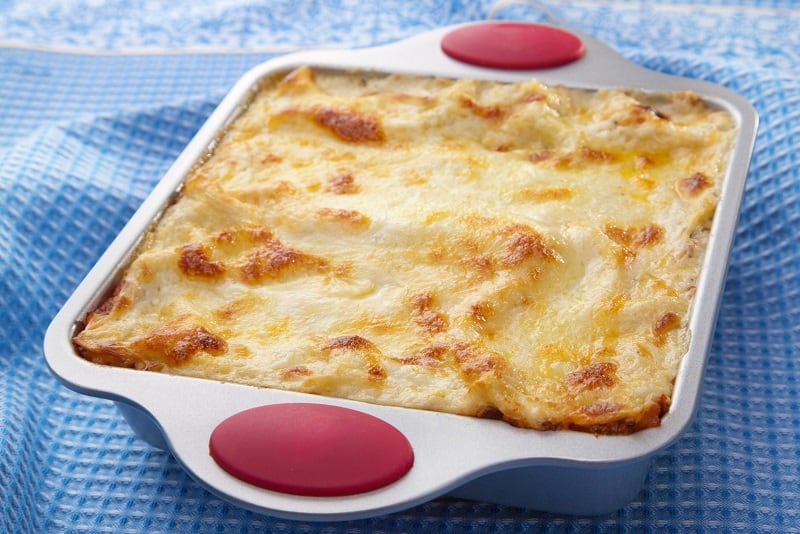Pasta is one of the world’s most well-loved foods, and for a good reason! No matter how it’s cooked, this versatile ingredient is sure to give you a warm, comforting meal that is cheap and easy to prepare.
One of the most popular pasta dishes in the world is lasagne. Traditionally, this dish is made with a meat ragu, but there are now thousands of recipes out there that change the ingredients so that it is suitable for all taste preferences and diets.
When making pasta, you must boil the shapes before adding sauces or other ingredients.
However, because lasagne is baked in the oven, there is a lot of confusion about whether you need to boil lasagne sheets of if you can just put them in the oven as they are. So do you need to cook lasagne sheets first? Read on to find out!
Is It Better to Boil Lasagne Sheets First?
The simple answer to this question is no. Lasagne sheets do not need to be cooked before layering them in your lasagne.
This is especially true for fresh lasagne sheets, as they are already quite soft and could end up mushy if they are accidentally overcooked in the oven.
However, some people prefer to soak lasagne sheets before using them, which is recommended in some recipes.
For example, this recipe from BBC Good Food suggests soaking the dried sheets in boiling water for 5 minutes before layering them in the lasagne.
This can help to improve the texture of the lasagne and prevent some of the sheets from remaining hard during the cooking process.
This being said, the moisture in the lasagne sauces is usually enough to thoroughly cook your lasagne sheets without boiling them beforehand.
If your pasta does tend to come out dry, the easiest solution is to ensure that each sheet is covered in a generous layer of sauce before the lasagne is placed in the oven.
Are Fresh Lasagne Sheets Better Than Dried?
When it comes to food, we are often taught that the fresher the ingredients, the better. This mindset can also be applied to pasta, so some believe fresh pasta is superior to the dried version. In reality, though, there is not much difference between the two.
The main distinction between fresh and dried pasta is that the former is made from flour and eggs, while the latter is made from flour and water.
However, this doesn’t significantly change the flavour or nutritional value of the dish and is more important in terms of diet.
In general, the type of pasta you choose to use depends on the sauce it is being paired with.
Fresh pasta is best when served with a butter-based sauce, and dried pasta with an oil-based one. Since lasagne uses a combination of both, you can use whichever kind of lasagne sheets you prefer.

How Do You Make Lasagne Sheets?
Fresh lasagne sheets can be purchased from most major supermarkets, but for an added touch, you can make your own at home without any specialist equipment.
It takes some time to make pasta from scratch, but the process is straightforward and only requires two ingredients: flour and eggs.
Below is a generic pasta recipe that can be used to make fresh lasagne sheets. For this recipe, you will need the following:
- Six large eggs
- 600g of type “00” flour
Method:
- Add the flour to a large bowl and create a small well in the centre. Then, crack your eggs into the well and beat the eggs until smooth.
- Use your hands to combine the beaten eggs and flour together until a dough starts to form.
- Transfer the dough to a lightly floured surface, then knead it for a few minutes until it forms a smooth ball and feels silky to the touch.
- Wrap the dough in clingfilm and leave it to chill in the fridge for at least 30 minutes.
- Once the 30 minutes have passed, remove the pasta dough from the fridge and roll it out using a rolling pin or pasta machine until it is roughly 2mm thick.
- Cut the pasta into strips or whatever size you desire for your lasagne sheets.
- Layer the sheets in your lasagne and bake as usual – no pre-cooking required.
If desired, you can also adapt these instructions to create other pasta shapes: Simply form the alternative pasta shape during step nine instead of the lasagne sheets.

How Do You Put Together a Lasagne?
The order in which you need to put together a lasagne has caused a lot of debate over the years.
Some people insist you should always start with a layer of lasagne sheets, others with the red sauce, and some with the white.
In the end, the way you build your lasagne layers is entirely up to you; the final result will taste the same no matter what order the ingredients are added to the dish.
However, we recommend starting with sauce (either red or white) so that the lasagne sheets at the bottom of the dish are properly cooked through.
A general set of instructions for building a lasagne is given below if you would like further guidance:
- Lightly butter your lasagne dish to prevent the pasta from sticking.
- Add a layer of red sauce to the dish, ensuring it is evenly spread.
- Place your lasagne sheets in a single layer on top of the red sauce, taking care to avoid overlapping the pasta too much.
- Top the lasagne sheets with a layer of white sauce and grated cheese.
- Repeat with the remaining ingredients, making sure to end with a final layer of white sauce and cheese on top.
No matter which order you layer your lasagne in, we highly recommend being generous with your layers.
The liquid in the red and white sauces is what cooks the lasagne sheets, so you need to thoroughly cover them to ensure the lasagne cooks properly.
Once layered, you can either bake it in the oven or store it in the freezer for later use.

Hannah is a freelance content writer and self-proclaimed foodie. When Hannah isn’t sitting tapping at her laptop, you’ll probably find her in the kitchen. As an ex-chalet host, she’s used to cooking four-course meals for 10+ people and loves feeding friends and family whenever possible.



